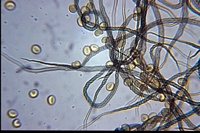|
 Trichia botrytis Trichia botrytis
SynonymsTrichia fragilis
Trichia fragilis var. cerifera
Stemonitis botrytis
Sphaerocarpus fragilis
BiostatusPresent in region - Indigenous. Non endemic
Images (click to enlarge)
Owner: J.A. Cooper |
Article: Cooke, M.C. (1879). New Zealand fungi. Grevillea 8(46): 54-68.
Article: Stephenson, S.L. (2003). Myxomycetes of New Zealand. Fungi of New Zealand. Ngā Harore o Aotearoa 3: xiv + 238 p. Hong Kong: Fungal Diversity Press.
Description: Fruiting body a stalked sporangium (rarely sessile or subplasmodiocarpous), often clustered on united stalks, 1–4 mm tall. Sporotheca turbinate or pyriform, dull olive-yellow to reddish or purplish brown, sometimes almost black, 0.6–0.8 mm in diameter. Stalk cylindrical, dull yellow or dark reddish brown or purplish brown, opaque, filled with amorphous material. Hypothallus usually contiguous for a group of sporangia, membranous, colourless to dark brown. Peridium consisting of two layers, the inner layer membranous, the outer composed or dark granular thickenings, sometime lacking, often separating before dehiscence and forming areolae separated by the lighter inner wall, dehiscence irregular. Capillitium dull yellow to dingy ochraceous brown in mass, elaters simple or sometimes branched, bearing 3–5 smooth spirals, 4–5 µm in diameter at the centre and tapering gradually to the long, slender, acuminate tips. Spores dull yellow to dingy ochraceous brown in mass, pale by transmitted light, minutely warted, 9–11 µm in diameter. Plasmodium purple-brown.
Habitat: Decaying wood.
Distribution: Widely distributed in temperate regions (Martin & Alexopoulos 1969). First reported (as Trichia fragilis) from New Zealand by Cooke (1879), based on a specimen collected in Southland. Also known from Bay of Plenty (Cheesman & Lister 1915), Buller, South Canterbury (Rawson 1937), and Stewart Island.
Notes: This species is somewhat similar morphologically to both Trichia decipiens and Metatrichia floriformis. However, it differs from the former in having a tough and rather dull peridium (the peridium of T. decipiens is membranous and shining) and from the latter in having an opaque stalk and a yellow-brown to dark ochraceous spore mass (in T. floriformis the stalk is translucent and the spore mass brick red to brownish orange).
|